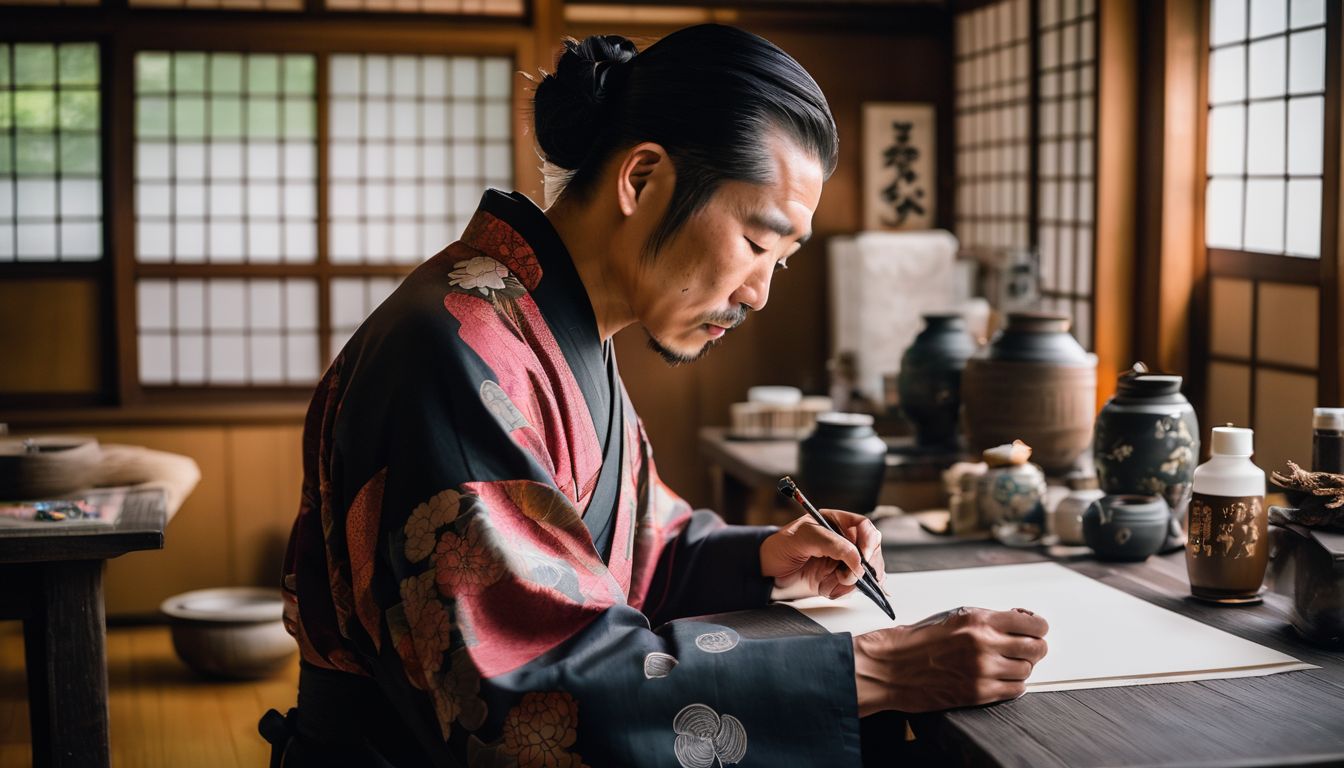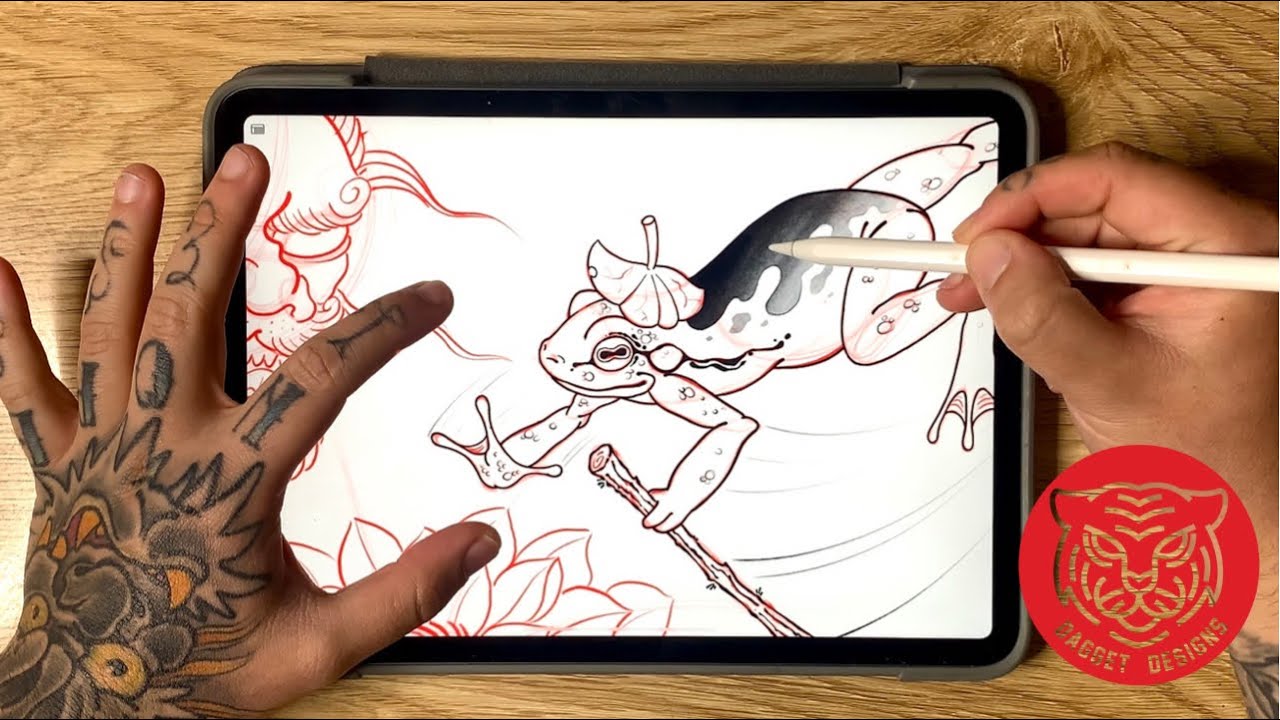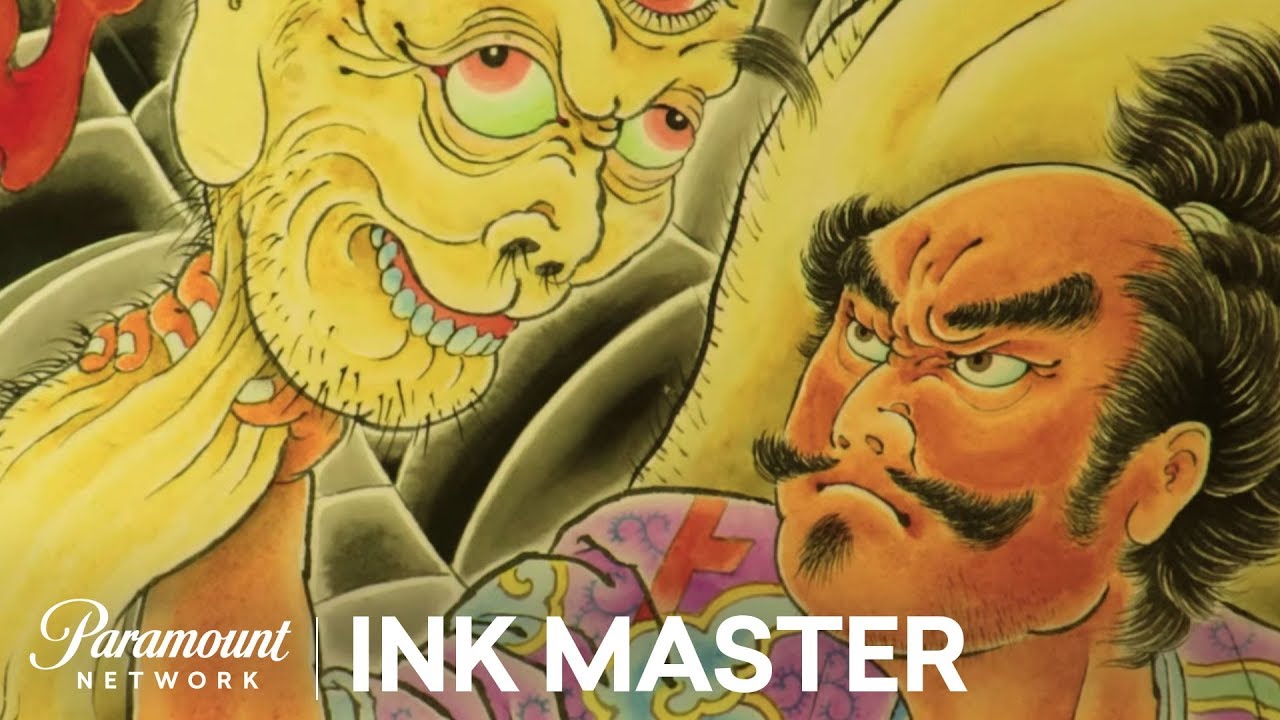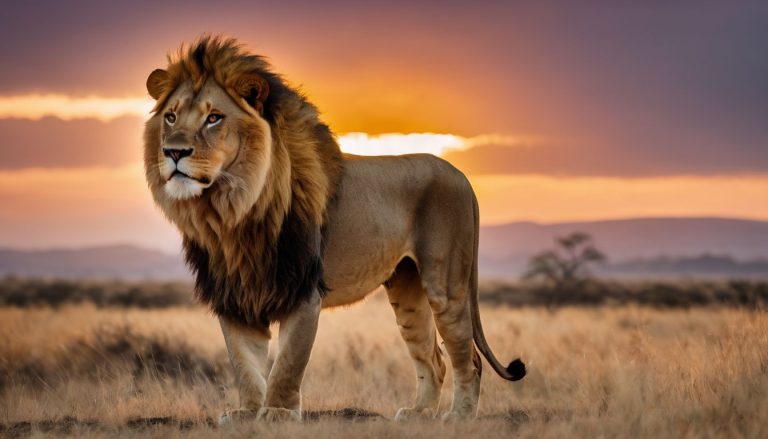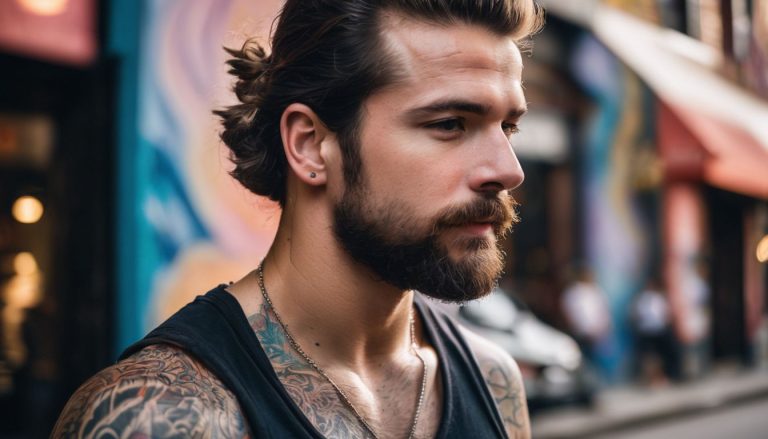Exploring the Rich History of Traditional Japanese Tattoos
Create your own unique tattoos and art for your home
Many people admire the bold beauty of Japanese tattoos but know little about their history. These intricate designs have been part of Japan’s culture for thousands of years, often signifying status and personal beliefs.
Our blog will unveil the storied past and rich symbolism behind traditional Japanese tattoos, guiding you through their meanings and evolution. Discover a hidden world inked with history!
Key Takeaways
- Traditional Japanese tattoos, known as Irezumi, date back to the Jomon period around 10,000 BCE. Originally symbols of spirituality and status, they evolved into marks of punishment during the Edo Period before becoming art forms that signify personal beliefs and identity.
- Designs such as dragons, tigers, koi fish, cherry blossoms, skulls, Hannya masks, and phoenixes carry significant cultural symbolism in Japanese tattooing. They express meanings like strength, protection, perseverance against adversity and the transience of life.
- The intricate full – body designs historically associated with members of the Yakuza have contributed to a negative stigma surrounding traditional Japanese tattoos. However modern perceptions are changing; these tattoos are now appreciated for their artistic value and connection to Japan’s rich heritage.
- Tattoo styles such as Tabori “Hand Tattooing,” Neo Japanese adaptation with modern influences on classic motifs showcase a blend of tradition with contemporary creativity within tattoo culture.
- When creating or choosing a traditional Japanese tattoo design it’s important to consider storytelling elements that reflect personal journeys or significance while ensuring optimal flow with natural body lines for visual impact.
History of Japanese Tattoos
Japanese tattoos have a long and complex history, originating as far back as the Jomon period and evolving into the iconic art form known today. Once associated with crime, yakuza members prominently displayed elaborate full-body tattoos that became synonymous with their criminal activities.
However, in modern times, traditional Japanese tattoos are increasingly recognized and celebrated for their cultural significance and artistic value.
Origin and evolution
Tattoos in Japan have a history that stretches back thousands of years. Early evidence points to clay figurines from the Jomon Period, around 10,000 BCE, with etched designs believed to be indicative of tattooing practices.
As time progressed, tattoos went from being symbols of spirituality and status to marks used by authorities for punishment during the Edo Period.
The art form continued to evolve significantly through different eras. During the Edo period, decorative tattooing became popular among laborers and merchants who were excluded from flaunting lavish clothing due to strict sumptuary laws.
These early tattoos often featured images borrowed from Japanese folklore and mythology like dragons or koi fish—designs still prevalent in traditional Japanese tattoo traditions today.
Tattoo artists honed their craft, developing unique styles such as Irezumi and embedding deep cultural significance into their intricate designs—a tradition carried forward into modern times where these historical motifs blend seamlessly with contemporary influences.
Association with crime
Traditional Japanese tattoos have long been associated with the criminal underworld, particularly through their connection to the Yakuza, which is Japan’s notorious organized crime syndicate.
In the past, these intricate full-body designs served as a badge of honor and loyalty to the organization, signifying a member’s commitment and obedience. This association between traditional Japanese tattoos and crime has led to stigmatization in society, contributing to negative perceptions of individuals adorned with such artwork.
Despite its historical ties to criminal activities, modern attitudes toward traditional Japanese tattoos have evolved significantly. Today, many people appreciate these tattoos for their artistic value and cultural significance rather than associating them solely with illicit behavior.
Yakuza tattoos
Yakuza tattoos, also known as irezumi in Japan, have been an integral part of the Yakuza culture for centuries. These elaborate and highly symbolic body art creations were initially worn as a sign of belonging to the notorious Japanese organized crime syndicate.
The intricate full-body designs served as a distinguishing feature among members and communicated their loyalty, status, and personal history within the Yakuza hierarchy. Each tattoo’s motif and placement carried specific meanings that represented a member’s role, achievements, or even criminal record.
Over time, these traditional Japanese tattoos became synonymous with notoriety and intimidation in Japan’s underworld.
The striking visuals of Yakuza tattoos often feature mythical creatures such as dragons and tigers alongside symbols like cherry blossoms or waves inspired by nature. Intricately detailed illustrations of folklore characters or scenes from Japanese mythology are commonly incorporated into these large-scale body art pieces.
Despite being associated with criminal activities historically, modern perceptions are gradually evolving due to increased awareness of the cultural significance behind these ancient tattooing traditions.
Modern perception and acceptance
Previously associated with the Yakuza and criminal activities, traditional Japanese tattoos have undergone a significant transformation in modern times. Today, these intricate and meaningful designs are increasingly accepted as a respected form of art and cultural heritage.
With growing interest in Japanese culture and symbolism, traditional Japanese tattoo designs are now appreciated for their historical significance, artistic value, and unique storytelling elements.
As more people understand the deep-rooted meanings behind these tattoos, they have gained wider recognition as an expression of personal identity and cultural appreciation rather than being solely linked to criminality or rebellion.
Traditional Japanese Tattoo Symbols
From dragons to cherry blossoms, traditional Japanese tattoos are rich in symbolism and meaning. Read on to explore the significance behind these timeless tattoo designs.
Dragon
The dragon is a prominent motif in traditional Japanese tattoos, symbolizing strength, wisdom, and protection. Depicted as a fearsome yet noble creature, the Japanese dragon often intertwines with other elements such as clouds and waves to create dynamic and visually striking designs.
These creatures are believed to possess powerful abilities that can bring good fortune and guard against evil spirits. In Japanese folklore, dragons are revered for their role as guardians of precious treasures and symbols of imperial power.
The intricate detail and vibrant colors used in traditional tattooing techniques bring these mythical creatures to life on the skin, making them a popular choice among those seeking meaningful and visually captivating designs.
Tiger
The tiger holds significant symbolism in traditional Japanese tattoos, representing strength, courage, and protection. In Japanese folklore, the tiger is believed to ward off evil spirits and bring good fortune.
Known as the “king of all beasts,” the tiger is often depicted with a fierce and majestic presence in Japanese tattoo art. Its vibrant colors and dynamic poses make it a popular choice for those seeking bold and striking designs that command attention.
Tiger tattoos are also associated with bravery and warrior spirit in Japanese culture, making them a powerful symbol of overcoming challenges and adversity. The intricate details of the tiger’s fur, claws, and expression embody resilience and determination, making it an inspiring motif for those looking to convey their inner strength through body art.
Koi Fish
Koi fish hold great significance in Japanese tattoos, symbolizing perseverance, strength, and determination. These colorful fish are often depicted swimming upstream against powerful currents, representing the ability to overcome adversity and achieve success.
The koi fish is also associated with good fortune and luck in Japanese culture. Its vibrant colors and flowing movements make it a popular choice for traditional Japanese tattoo designs.
The intricate patterns of scales and majestic presence of the koi fish make it a captivating subject for tattoo artistry. Whether portrayed alone or alongside other traditional symbols like lotus flowers or water lilies, the koi fish continues to be an enduring motif in Japanese tattooing.
Cherry Blossom
Cherry blossoms, known as “sakura” in Japanese, hold deep cultural significance in traditional Japanese tattoos. These delicate and beautiful flowers symbolize the transient nature of life, beauty, and mortality.
In Japanese culture, cherry blossoms are associated with the samurai code of honor and represent the fleeting nature of life. When used in traditional tattoo designs, cherry blossoms often accompany other symbols such as dragons or tigers to convey specific meanings related to strength, courage, or rebirth.
Cherry blossom tattoos are a popular choice for those seeking to embrace the ephemeral beauty of life and pay homage to Japanese tradition through body art. The intricate details of cherry blossom petals can be depicted in various shades from pink to white along with vibrant green leaves to create stunning tattoo designs that capture the essence of this revered flower.
Skull
Moving from the delicate beauty of the cherry blossom to a symbol with deeper, darker connotations, the skull is a powerful motif in traditional Japanese tattoos. Unlike its association with death and danger in Western cultures, the skull holds different meanings in Japanese tattoo symbolism.
It often represents change or transformation, reminding wearers of their mortality and the fleeting nature of life. The image of the skull can also signify protection against evil spirits or bad luck, serving as a ward against negative forces.
In some cases, it is associated with perseverance and strength during challenging times. When incorporated into traditional Japanese tattoos, skulls are often adorned with intricate details and surrounded by other symbolic elements like flowers or animals.
Hannya Mask
Moving from the foreboding imagery of skulls, we encounter the traditional symbol of the Hannya mask in Japanese tattoo art. This iconic mask represents a vengeful and jealous female demon from Noh theater, often embodying themes of transformation and inner conflict.
The intricate design of the Hannya mask makes it a captivating choice for tattoos, conveying complex emotions and storytelling within its striking visage.
The Hannya mask is often depicted in vibrant colors and bold lines to emphasize its dramatic expression, making it a popular subject for those seeking to convey intense emotions or personal struggles through their tattoo art.
Phoenix
The phoenix is a powerful symbol in traditional Japanese tattoo art, representing rebirth, renewal, and immortality. This mythical bird is often depicted rising from the ashes, embodying resilience and strength.
In Japanese culture, the phoenix is known as Ho-oo and holds deep spiritual significance. Its vibrant plumage and majestic presence make it a popular choice for those seeking a tattoo that symbolizes overcoming adversity and embracing new beginnings.
In traditional Japanese tattoo motifs, the phoenix is intricately detailed with flowing lines and rich colors to capture its regal essence. Tattoo enthusiasts who resonate with themes of transformation and triumph often choose the phoenix as a striking centerpiece for their designs.
Traditional Japanese Tattoo Styles
Irezumi, Tabori “Hand Tattooing,” Neo Japanese, and Munewari are the traditional styles of Japanese tattooing that have evolved over centuries. Each style has its own unique techniques and aesthetic appeal.
Irezumi
Irezumi, a traditional Japanese tattooing technique that has been around for centuries, involves using hand methods to create intricate and detailed designs. The process typically entails striking ink into the skin with tools such as bamboo handles and sharp needles.
Irezumi is known for its highly symbolic imagery, often featuring motifs from nature, mythology, and folklore. These tattoos are designed to cover large areas of the body such as the back, chest, and arms, resulting in visually stunning full-body suits or “irezumi.” The art form demands a high level of skill and expertise from the tattoo artist due to its complexity and significance.
Tattoo history
Traditional Japanese art
Tabori “Hand Tattooing”
Transitioning from Irezumi, Tabori “Hand Tattooing” is another traditional Japanese tattoo style that holds a significant place in the history and culture of Japanese body art.
Unlike modern electric machine tattooing, Tabori involves the skilled use of a handheld bamboo rod with needles attached to create intricate designs directly onto the skin. This technique requires exceptional precision, as it demands complete control and concentration from the artist.
The process is not only a form of art but also an intimate experience between the artist and the recipient, fostering a deep connection between them.
Artists practicing Tabori “Hand Tattooing” are highly revered for their craftsmanship and dedication to preserving this ancient tradition. The style has gained recognition globally for its unparalleled attention to detail and authentic representation of Japanese cultural motifs.
Neo Japanese
Transitioning from Tabori “Hand Tattooing,” the Neo Japanese tattoo style has become increasingly popular in contemporary tattoo culture. This modern fusion draws inspiration from traditional Japanese motifs while incorporating new elements.
Neo Japanese tattoos often feature vibrant colors, intricate details, and a mix of traditional Japanese symbols with modern design techniques like realism and illustrative styles. Artists use this approach to create visually stunning pieces that pay homage to the rich tradition of Japanese tattooing while infusing it with fresh creativity and innovation.
Incorporating bold lines, dynamic compositions, and vivid color schemes, Neo Japanese tattoos bring a refreshing twist to classic themes such as dragons, koi fish, and cherry blossoms.
Munewari
Transitioning from the modern Neo Japanese tattoo style to a more traditional approach, Munewari is known for its placement on the front of the body. This particular style focuses on intricate designs centered around the chest, often integrating symbolic elements such as flowers, dragons, or other traditional motifs.
Munewari tattoos hold great cultural significance and are considered a bold statement that demands respect within Japanese tattoo culture. The process of designing and receiving a Munewari tattoo involves careful consideration of both historical symbolism and personal meaning.
Munewari tattoos have deep roots in Japanese tradition and carry a sense of honor and commitment due to their painful application process. For those seeking to embark on this traditional journey, it’s essential to find an experienced artist who understands the cultural significance behind these striking designs.
Cultural and Mythological Significance in Traditional Japanese Tattoos
Animals, characters, and natural elements hold deep cultural and mythological significance in traditional Japanese tattoos. From creatures like dragons and tigers to iconic symbols such as cherry blossoms and skulls, each design carries a rich history and meaning rooted in Japanese folklore and mythology.
Animals in Japanese Tattooing
Animals play a significant role in Japanese tattoo art, symbolizing various attributes and characteristics. The tiger represents strength, courage, and protection, commonly seen in traditional Japanese tattoos.
Similarly, the dragon is a powerful and mythical creature symbolizing wisdom, prosperity, and good fortune. Koi fish are often associated with perseverance and overcoming obstacles in life.
These animals hold deep cultural significance in Japanese tattooing and are intricately woven into the rich tapestry of traditional designs.
Traditional Characters and Mythology
Traditional Japanese tattoos often feature characters and mythology deeply rooted in the country’s folklore. These designs frequently depict famous figures from Japanese history, such as samurai warriors or mythical creatures like dragons and yokai.
Additionally, popular stories like those of Momotaro, a boy born from a peach who became a hero, or the tale of Urashima Taro, who rescued a turtle and was rewarded with an underwater kingdom, are also common themes found in traditional Japanese tattoo art.
Mythological symbols present in these tattoos hold significant meanings in Japanese culture and belief systems. For example, dragons represent strength and wisdom while koi fish symbolize perseverance and good fortune.
Natural Elements Used
Moving on from traditional characters and mythology, natural elements play a significant role in traditional Japanese tattoo designs. These elements often hold deep symbolic meanings and are integrated into tattoos to convey specific messages or evoke certain emotions.
The use of natural elements such as water, wind, fire, and earth not only adds visual interest to the design but also represents various aspects of life, resilience, and the ever-changing world.
Animals are also commonly incorporated into Japanese tattoos as representations of natural elements; for example, koi fish symbolize perseverance and determination while dragons are associated with strength and wisdom.
Tips for Creating and Choosing a Japanese Tattoo Design
Consider the importance of storytelling in your design, ensuring that it reflects your personal journey or meaning. Look for a design that flows well with the natural lines and curves of your body, with high contrast and bold line work to make a strong visual impact.
Work closely with a skilled tattoo artist who specializes in Japanese designs to bring your vision to life.
Importance of storytelling
Storytelling is an essential aspect of traditional Japanese tattoos, as each design often carries deep cultural and mythological significance. The incorporation of storytelling into tattoo designs allows for the portrayal of powerful narratives and symbolism that reflect personal experiences or values.
By conveying these stories through intricate images such as dragons, tigers, or cherry blossoms, individuals can create a visual representation of their journey and beliefs within the rich tapestry of Japanese tattoo art.
The importance of storytelling in Japanese tattooing lies in its ability to connect the wearer with the historical and symbolic themes embedded in traditional designs. Through skillful storytelling within tattoo art, individuals can celebrate their cultural heritage while simultaneously expressing their own unique narratives through these timeless symbols.
Flow of the body
After considering the importance of storytelling in Japanese tattoo design, it’s essential to focus on the flow of the body. Ensuring that a traditional Japanese tattoo design complements and enhances the natural contours and movements of the body is crucial.
This involves strategic placement of elements to suit different body parts, such as arms, legs, back, or chest. The goal is to create a harmonious composition that follows the muscle structure and curves of the body while maintaining balance and symmetry.
To achieve optimal flow, artists pay close attention to how different symbols and motifs interact with each other across various parts of the body. They consider factors like movement direction, positioning relative to joints or bone structure, and integration with existing tattoos if applicable.
High contrast and bold line work
When considering traditional Japanese tattoo designs, it is essential to emphasize high contrast and bold line work. These elements are crucial in ensuring that the intricacy and details of the design stand out, creating a visually striking piece.
By using strong contrasts between light and dark shades, along with bold lines, traditional Japanese tattoos can achieve a level of depth and clarity that enhances their overall impact.
Incorporating high contrast and bold line work also plays a significant role in preserving the longevity of the tattoo. The use of these techniques helps prevent the design from blurring over time, maintaining its sharpness for years to come.
Use of color
Traditional Japanese tattoos utilize a limited but striking color palette, often using black, red, and some shades of blue or green. These colors are chosen carefully to convey specific meanings; for instance, the use of vibrant red symbolizes life and vitality while black signifies strength and wisdom.
The contrast between these colors enhances the overall impact of the tattoo design, creating visually captivating artwork that tells intricate stories and reflects deep cultural and mythological significance.
Additionally, traditional Japanese tattoos incorporate shading techniques to add depth and dimension to the designs. This meticulous application of color results in mesmerizing imagery that flows seamlessly with the body’s natural contours.
By understanding the symbolism behind different hues and their placement within a tattoo design, individuals can create meaningful pieces that honor Japanese tradition while expressing personal narratives through this ancient art form.
Working with a tattoo artist.
When considering getting a traditional Japanese tattoo, finding the right tattoo artist is crucial. Look for an artist experienced in Japanese tattooing who understands the cultural and mythological significance behind these designs.
It’s important to have open communication with your tattoo artist, so they can create a design that reflects your personal story while staying true to traditional Japanese symbolism.
After finding a potential artist, take the time to review their portfolio and discuss your ideas with them. This allows you to gauge their skills and ensures they understand your vision before committing to the design process.
Conclusion
Exploring the rich history of traditional Japanese tattoos reveals a captivating journey through time. From their origins to modern acceptance, these tattoos reflect deep cultural and mythological significance.
Understanding the symbols, styles, and meanings provides valuable insight for creating and choosing Japanese tattoo designs that honor this ancient art form.
FAQs
1. What is the history behind traditional Japanese tattoos?
The rich history of traditional Japanese tattoos dates back centuries and connects deeply with traditional Japanese art, culture, and society’s beliefs.
2. Are there specific symbols used in traditional Japanese tattoo designs?
Yes, traditional Japanese tattoo symbols include dragons for strength, koi fish for perseverance, and cherry blossoms to symbolize life’s fragility.
3. Do traditional Japanese tattoos have special meanings?
Absolutely! Each design in a Japanese traditional tattoo sleeve or stand-alone piece carries unique meanings tied to nature, spirituality, and personal virtues like bravery and honor.
4. What are some common rules for getting a Traditional Japanese Tattoo?
Japanese traditional tattoo rules often involve respecting the art form’s cultural significance by understanding the imagery used and choosing designs that align with their intended meaning.
5. Can you find ideas for a black and grey Traditional Japanese tattoo?
Certainly! There are plenty of ideas available for black and grey japanese Traditional Tattoos featuring intricate shading techniques that bring out the beauty of these historic designs.

